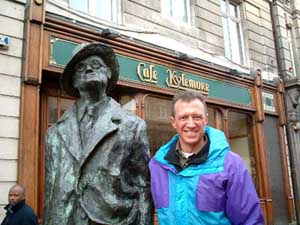|
Rourke Does Ireland
|

Rourke O’Brien and James Joyce – sort of.
|
Another home-grown program showing once again, the BBRC has a powerful bunch of members ready to tell their special stories. Friday, it was Rourke O’Brien, relating his odyssey around the Emerald Isle, as he visited his roots in Ireland.
[Prior to beginning the program, Kim Shrader was going to adjust the light that was shining on the screen. The question posed was “How many Rotary presidents does it take to turn off a light?” Turns out: none. Someone turned out the light at the switch!]
Rourke began by saying that his trip was created by an “impulse to visit my namesake, Ireland, and Ireland will never be the same! His first slide showed how he prepared for the journey. “Generally, I had no preparation. I bought a backpack. My itinerary was to arrive in Dublin and be back at the airport in three weeks! Transportation was to be accomplished by a thumb.” Rourke went back to the basics.
He planned a trip around the whole island, which is the size of West Virginia. “I checked for my family members in the phone book – O’Brien is the fifth largest listing!”
Some of the highlights included numerous Heritage Centers, where historical information about the Irish Clans is displayed. “There are Castles – lots of them – churches, 90% of which are Catholic. These are gorgeous buildings.”
There are monuments and statues everywhere. The Irish potato famine of 1845-1850 gets lots of space. “I like Northern Ireland a lot,” said the intrepid traveler. His journey started at Kinsale on the Southeast Coast, where the English entered Ireland in 1601. “That’s when the problems started, so say the Irish.”
|

Rourke, holding up the Dingle Pub – or vice versa.
|
There’s the awesome Dingle Peninsula, a beautifully rugged place. This is where you find the Croagh Patrick, a mountain that St. Patrick climbed in 441 AD, and from where he rid the country of snakes and reptiles. The pilgrimage each year counts thousands of people climbing the steps to pay homage to Ireland’s patron saint.
In Dingle Bay is the Coffin Ship, a monument to those leaving Ireland. Half of the immigrants died before they reached their destination. Today, Ireland has a population of five million.
Rourke saw the Giants Causeway, an amazing series of rock formations. At Newgrange, carbon-dating has identified a tomb back to 3200 BC. At the winter solstice, the light pours through a window for precisely 17 minutes – a very interesting place.
In Dublin, Rourke saw some priests exorcising buildings. He saw a peace rally in Galway (“I’d move there in a minute”) and then spent quite a bit more time than he expected in Northern Ireland. During his three-week trip, he’d see people doing the same thing he was – backpacking around the island. So, every so many days, he’d bump into someone he’d met several days earlier. Kind of a family connection.
Rourke was fascinated by the area of Derry or Londonderry. The Catholics call it Derry, the Protestants, Londonderry. Most of the friction over the years has occurred in this city, as the line is drawn right between the two warring factions. There are murals on buildings that take the Unionist side and across the street, there’s another taking the Loyalist side.
He enjoyed his stay in the Northern Ireland capital of Belfast. He saw where the Titanic was built. His lodging arrangements were generally hostels, or Bed & Breakfasts. “I met people from all over the world. It cost $10-16 dollars a night. Hostel life is like a big frat party that goes on for 3 weeks!
|

The Dingle Peninsula
|
And, then there’s pub life, what Rourke described as the “social fabric of the entire country.” He visited the Crown Pub in Belfast, which dates back to 1600. He did some heavy research at Bushmill’s Distillery. “Don’t go to Bushmill’s and then try to navigate the Giants Causeway, as I did. It’s not recommended!” There are Internet Cafes all over the country, and that’s how people are communicating back home these days. As Rourke observed, the “single major reason that Ireland is so special is because of the people. They are a wonderful lot.”
A member of the audience commented about Ireland’s tremendous economic strides. This person noted the country’s fast growth and even hinted that The Boeing Company could be assembling planes there in the not too distant future. Ireland was one of the major benefactors from the conversion to the Euro and provided much of the support for this new redefinition of Europe.
Not many of us would head for our country of origin and begin a backpacking tour, but Rourke did, and seemed very happy that the Irish and Ireland were there for him to meet. It looked like love at first sight.
For his presentation, Rourke was awarded a certificate for the purchase of 240 doses of polio vaccine to be contributed to Rotary’s effort to eradicate the disease. Thanks to Mary Bell who provided the introduction.
|